by Djavad Salehi-Isfahani
The timing of the fall in global oil prices could not have come at a worse time for the government of Hassan Rouhani in Iran. A decline of 30% in oil revenues, which he noted in a recent speech, severely limits his government’s ability to maintain the modest growth momentum started last year, and weakens Iran’s position in the negotiations over its nuclear program—getting around the sanctions is hard enough with plenty of cash.
A dire economic situation is being predicted, by diverse sources from the Wall Street Journal to The Guardian, suggesting that Iran needs a price of $140 per barrel to “break even” and “stay afloat.” With the oil price at almost half of that level, are Iran’s leaders staring into a deep economic crisis? Will they be forced to compromise in this last week of negotiations?
The answer is no. Unlike oil companies, countries do not have a break-even price; they have budgets to balance, and several ways to adjust to lower oil prices. Adjusting to lower export income is painful, but like most oil exporting countries, Iran has been there before, and also has new ways to deal with a shortfall.
The recent drop in the price of oil also exaggerates the loss of value of export earnings. Because the price of oil is denominated in US dollars, and the US currency has appreciated relative to other currencies by about 10% in recent months, the decline in the buying power of oil is closer to 20%, less than the 30% decline in the price of oil.
The fact that the value of the rial relative to the US dollar has remained stable as the price of oil has been falling (and while the ruble lost 23% of its value), also suggests that Iranians are not expecting the worst in the near future.
Nevertheless, Iran has to make a sizeable adjustment in its budget for this year, in the $2.5-$5 billion range, depending on how oil prices behave for the rest of this Iranian fiscal year, which ends on March 20, 2015. (For most of this year, Iran has sold its oil at above $100 per barrel.) This is a shortfall of about 6-12% in the projected revenues and expenditures of $74 billion for the current year. To keep his promise of not borrowing from the Central Bank, Rouhani will probably choose to cut expenditures, perhaps lengthening the already long queue of unfinished public projects, rather than engage in inflationary finance.
It is a different story for next year’s budget (2015/2016), which is in preparation now. The government faces two sources of uncertainty, one of which should resolve soon, perhaps by next week when we find out whether the talks between Iran and the P5+1 (US, Russia, China, UK, France, plus Germany) in Vienna, currently in a marathon session, resulted in a final deal by the Nov. 24 deadline.
The first uncertainty, about the future price of oil, will remain uncertain for months if not years to come. In the past, OPEC has proved powerless in preventing prices from falling in a weak market, so its upcoming November meeting will not resolve much.
The future of sanctions against Iran, a toss-up at this moment, will become clear soon enough, but we can speculate anyway.
If an agreement is reached by next week or weeks after that, then lower oil prices will do much less damage to Iran’s hopes for a full economic recovery. More of Iran’s frozen assets will become available and, more importantly, Iran will be able to export more oil—by as much as one million barrels per day—partially counteracting the decrease in the price of oil.
The worst-case scenario would occur if the negotiations fail and the price of oil continues to decline, two events that can happen simultaneously despite the fact that no deal would raise uncertainty about the peaceful flow of oil from the Middle East, which would tighten the oil market.
In this scenario, three options remain for the government to balance its budget and for the economy to stumble along. Cutting expenditures will be difficult because they are at a historic low, and raising taxes will be difficult administratively and imprudent politically. So, the government is likely to look for the third option, made available thanks to a subsidy reform program that Rouhani’s nemesis, former President Mahmoud Ahmadinejad, launched in 2010.
A third phase of the subsidy reform, which is currently awaiting implementation, could just be the life-saving mechanism for Rouhani’s budget-balancing plan. The new budget will likely include some increase in the price of energy anyway, but in the event of no deal, the increase will have to be much larger—in the order of 50% more.
Increased energy prices could be a win-win measure, to use Rouhani’s favorite motto. They could help balance the budget, reduce energy waste and environmental damage, and protect the poor. The latter would be possible thanks to a program implemented during Ahmadinejad’s term that replaced energy subsidies with cash. About 95% of Iranians currently receive a cash transfer of about $15 per person per month ($45 in international PPP dollars).
And there are plenty of subsidies left to remove and reallocate. Iran sells three times as much oil and gas domestically as it exports, but because domestic prices are highly subsidized, only the latter brings in any revenues. Gasoline, about half of which is consumed by people who make up the top 20% of income-earners, sells for about $1 per gallon, after two previous adjustments.
Tapping into this important source of revenues, next year’s budget could be balanced by raising energy prices while at the same time compensating the poorest sections of Iran’s society for their loss of buying power. Iran’s energy subsidies are highly regressive, so it is possible to raise revenue by removing them without hurting the poor.
Rouhani and his supporters have been quite critical of Ahmadinejad’s cash transfer program, preferring stimulating production to redistribution, and private-sector jobs for the poor over government cash handouts. But if a final deal falls through and the government has to raise substantial amounts of revenue by raising energy prices, increasing the amount of cash transfers might be the best way to protect the lower income families from falling into poverty.






Playing the waiting game. All the stops are being pulled to prevent an agreement, but who will blink first? The sad truth about the U.S., is “O” being held captive by the neocon element in the country. As the saying goes, they gather when the smell of blood is in the air, all the me too’s, I told you so’s, anything to prevent “O” from getting any credit if a solution does occur. One has to wonder how all these immature inmates of the asylum became politicians? Oh, that’s right, “superiority complex coupled with delusional denial”.
$140 beak-even? Who trusts the WSJ on Iran? Nobody.
Let’s look at some history:
Annual Average Domestic Crude Oil Prices
($/Barrel)
year – nominal – inflation-adjusted
2009 $53.48 $58.20
2010 $71.21 $76.38
2011 $87.04 $90.52
2012 $86.46 $88.11
2013 $91.17 $91.54
US enemies (and there are many) no longer need to trade oil in dollars, but are using currency swaps and commodity swaps. Iran has gained expertise in circumventing US economic aggression. Iran will cope. It has a lot of friends who need oil.
Imam Hussain is my hero
Iranians follow Imam Hossein